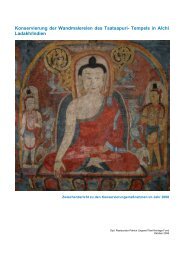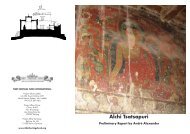Beijing Hutong Conservation Plan - Tibet Heritage Fund
Beijing Hutong Conservation Plan - Tibet Heritage Fund
Beijing Hutong Conservation Plan - Tibet Heritage Fund
You also want an ePaper? Increase the reach of your titles
YUMPU automatically turns print PDFs into web optimized ePapers that Google loves.
20<br />
3.2 Dangers to the old city<br />
3.2.1 Natural disasters<br />
<strong>Beijing</strong> is located in the earthquake zone of the Hua Bei plain. In 1976, a major earthquake, measuring 7.8 on the Richter scale, hit the <strong>Beijing</strong> area, with<br />
its epicentre at Tang Shan (a town 180km from <strong>Beijing</strong>). <strong>Beijing</strong> was directly affected, with more than 28000 buildings collapsing in eight districts of<br />
<strong>Beijing</strong>. In addition, 100 000 buildings were damaged and classified as dangerous. In <strong>Beijing</strong>’s old city area, it is still possible to see traces of damage<br />
from the Tang Shan earthquake.<br />
3.2.2 Damage and Development<br />
Historic events in China’s turbulent history have left their mark on the country’s ancient capital. In the past<br />
century, the Boxer Uprising, the Invasion of Eight-Powers, the Japanese war and the civil war, and indeed<br />
the Cultural Revolution, have all taken their toll on <strong>Beijing</strong>’s cultural heritage. Research carried by Tsinghua<br />
University indicates that over the past 40 years, especially during the Cultural Revolution, 22.5 kilometer of<br />
city wall, 22 turrets towers, and many famous imperial parks and Si-He-Yuan buildings, were damaged<br />
(Ref: “Contemporary Redevelopment in the Inner City of <strong>Beijing</strong>: Survey, Analysis and Survey, PhD study<br />
by Mr. Fang Ke, published by Tsinghua University in June 2000).<br />
Chong Wen Men in 1901<br />
Since the late 1980s,and throughout the 1990s, China’s social and economic systems developed with<br />
concomitant rises in land and property prices. The resulting property redevelopment business led to the<br />
dismemberment of many historic neighborhoods and buildings in central <strong>Beijing</strong>. Important sites were officially<br />
earmarked as cultural relics sites and were protected. Unfortunately preservation plans gave no detailed concept<br />
for the preservation of complete historic districts. The speed of the demise of the <strong>Beijing</strong> <strong>Hutong</strong> has been<br />
measured at 600 lanes per year, (ref: Xin Bao newspaper and research by the archaeologist Xu Pingfang). Most<br />
demolished <strong>Hutong</strong>s have been replaced with skyscrapers built by property developers. Developments such as<br />
Dong Fang square, Financial Street, and Jiao Dao Kou flats all stand on the sites of ancient <strong>Hutong</strong>s. The rapid<br />
decrease of <strong>Beijing</strong>’s historic areas quickly became a nationwide and even international concern.<br />
The government recognises that the extinction of the <strong>Beijing</strong> <strong>Hutong</strong> is undesirable, and has begun to develop<br />
more preservation concepts. The latest plan, published in 2002, is ‘<strong>Conservation</strong> <strong>Plan</strong>ning of Historical & Cultural<br />
City of <strong>Beijing</strong>’. This gives 25 <strong>Hutong</strong>s protected status. Since the publication of this plan, 15 more <strong>Hutong</strong>s have<br />
been listed. The plan recommends protection. Its success hinges on strict implementation, which may well be<br />
hindered by the unsolved contradiction between Development and Preservation. If the government’s preservation<br />
efforts succeed, they will bring huge cultural and social benefits. The present report aims to support these ideas<br />
and develop them further to suggest some workable solutions.<br />
Jiao Dao Kou residencial flats built in<br />
2002, a new building appearing in<br />
historical quarter.




